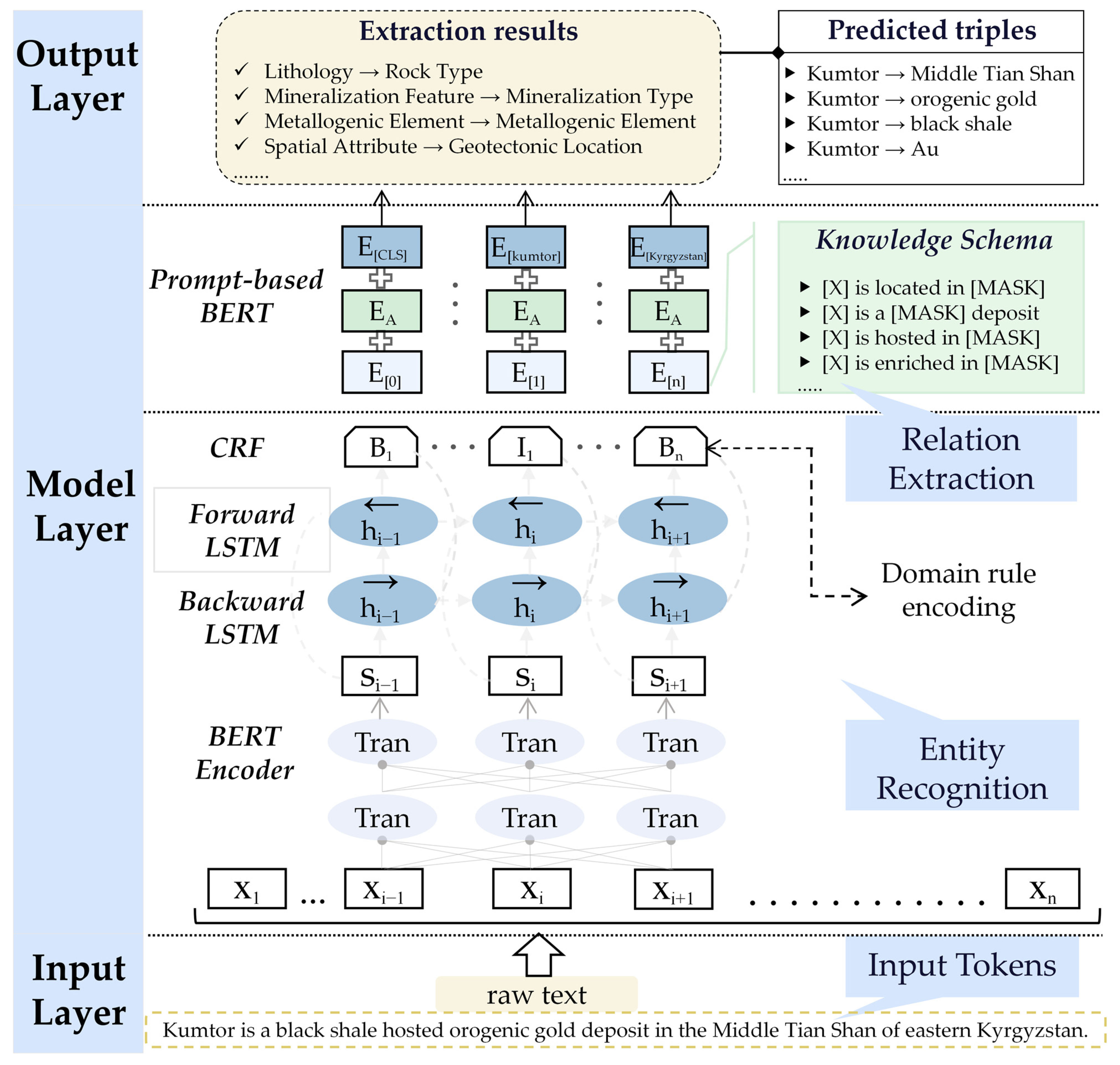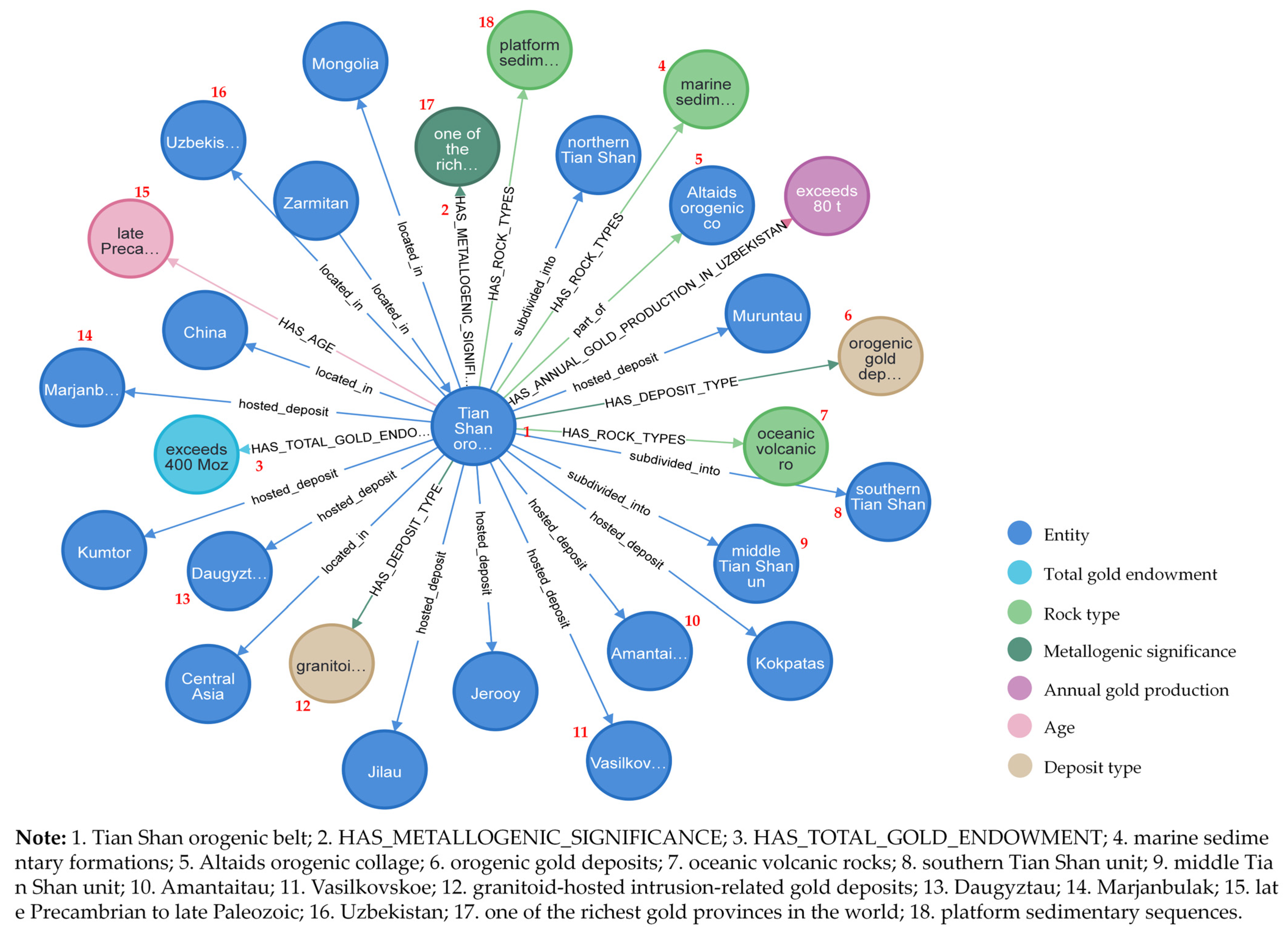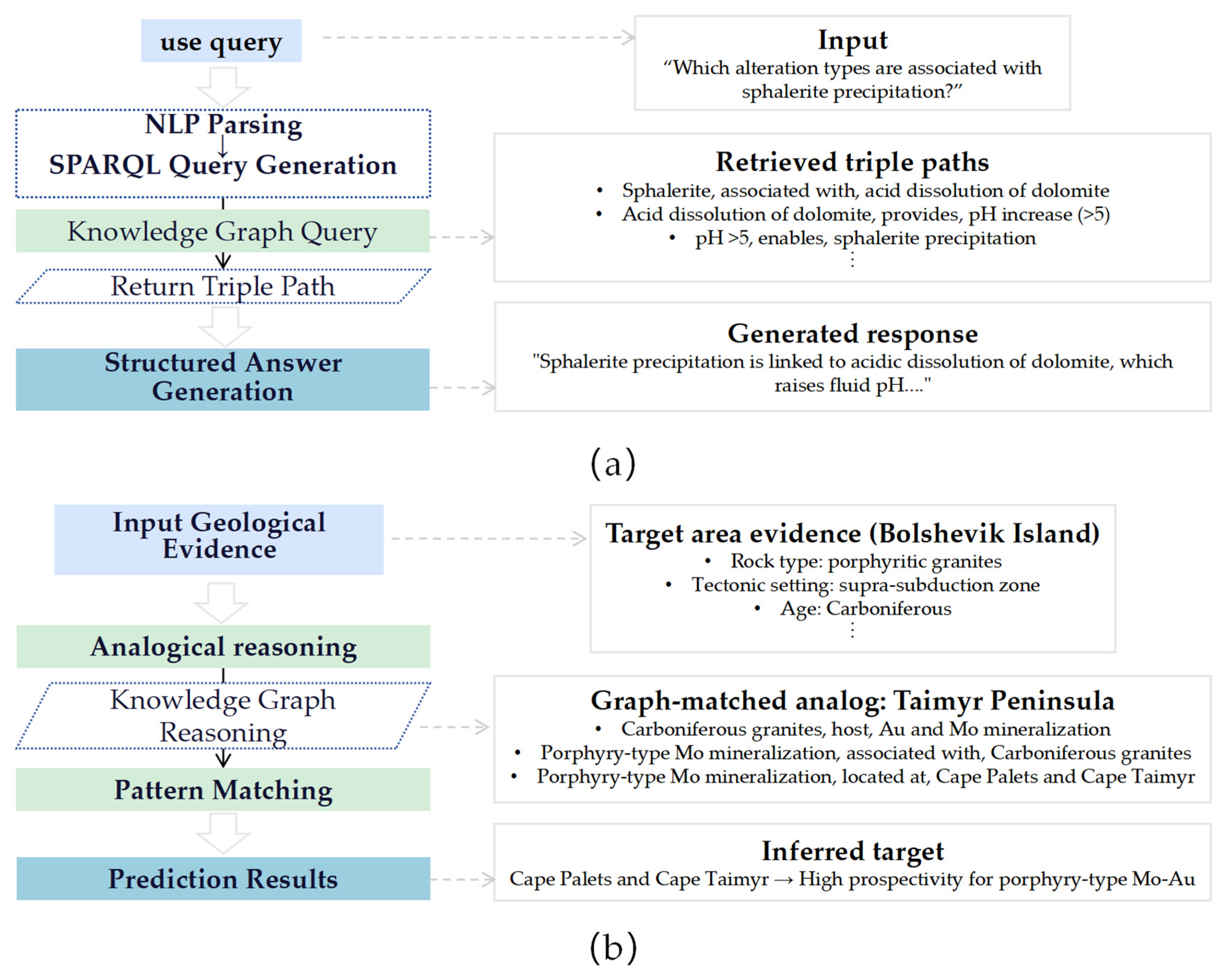Semantic-Aware Fusion of Mineral Exploration Knowledge Streams Towards Dynamic Geological Knowledge Graphs
Abstract
1. Introduction
2. Data and Methods
2.1. Data Sources and Knowledge Stream Collection
2.1.1. Multi-Source Heterogeneous Data Collection and Corpus Quality Control
2.1.2. Domain-Specific Annotation and Training Set Construction
2.2. Schema-Guided Knowledge Extraction
2.3. Dynamic Semantic-Aware Fusion of Heterogeneous Knowledge Sources
- (1)
- Translating heterogeneous knowledge into S-aligned triples.
- (2)
- Dynamically detecting and resolving conflicts based on semantic consistency.
2.3.1. Schema-Aligned Translation and Semantic Typing
- (Zarmitan, Located in, Central Uzbekistan);
- (Zarmitan, Resource Estimate, “10 Moz Au”);
- (Zarmitan, Metallogenic Element, “Au”);
- (Zarmitan, Primary Host Rock, “granite”);
- (Zarmitan, Associated Host Rock, “sedimentary rock”);
- (Zarmitan, Mineralization Type, “quartz vein”);
- (Zarmitan, Developed in, Granite).
2.3.2. Conflict Detection and Dynamic Integration
- Peer-reviewed literature (highest priority);
- Technical reports and exploration summaries;
- Regional geological surveys and open databases (lowest priority).
2.4. Knowledge Graph Export and Validation
- Nodes represent domain-specific geological entities defined in the ontology (see Appendix A), such as Mineral Deposit and Ore Block;
- Relationships capture semantic associations between entities, including Located in and Developed in, as formally specified in the schema;
- Properties store quantitative and qualitative attributes associated with nodes or relationships, such as Geotectonic Location and Morphology.
3. Results
3.1. Corpus Statistics and Domain Coverage
3.2. Performance of GeoKE Framework
3.3. Outcomes of Knowledge Fusion and Conflict Resolution
3.4. Structural Overview of the Integrated Knowledge Graph
4. Discussion
4.1. Accuracy Evaluation of Knowledge Extraction: A Quantitative Comparative Analysis
4.2. Semantic-Aware Knowledge Fusion Strategies: Transforming Data into Interpretable Knowledge
4.3. Enabling Geological Intelligence Through Structured Knowledge Graphs
- (1)
- Illustrative Example: The Tian Shan Orogenic Belt
- (2)
- Intelligent Question Answering
- (3)
- Mineral Prospectivity Prediction
5. Conclusions
Author Contributions
Funding
Data Availability Statement
Acknowledgments
Conflicts of Interest
Abbreviations
| GeoKE | Schema-guided Geological Knowledge-aware Extraction |
| BERT | Bidirectional Encoder Representations from Transformers |
| Bi-LSTM | Bidirectional Long Short-Term Memory |
| CRF | Conditional Random Field |
| S | Schema |
| P | Precision |
| R | Recall |
| F1 | F1 Score |
| Gfused | Fused Knowledge Graph |
| Mindat | Mindat.org |
| MRDS | Mineral Resources Data System |
| LCC | Largest Connected Component |
| NLP | Natural Language Processing |
| SPARQL | SPARQL Protocol and RDF Query Language |
Appendix A
| ID | Category | Entity/Attribute Name | Definition and Scope | Value Type | Example(s) | Notes |
|---|---|---|---|---|---|---|
| E1 | Geological Entity | Ore District | A geographically or administratively defined area with concentrated mineralization | String | Kumtor Gold District, Kyrgyzstan | May contain multiple deposits |
| E2 | Geological Entity | Mineral Deposit | An economically significant mineralized body with a distinct genetic system | String | Oyu Tolgoi Copper–Gold Deposit, Mongolia | Fundamental unit for metallogenic analysis |
| E3 | Geological Entity | Ore Block | A subunit within a deposit controlled by structure or lithology | String | North Block, Oyu Tolgoi | Common in detailed exploration reports |
| E4 | Geological Entity | Orebody | A mineralized body with defined boundaries, shape, and attitude | String | No. 2 Orebody, Chuquicamata, Chile | Direct target of drilling and sampling |
| E5 | Geological Entity | Intrusive Body | An igneous intrusion genetically related to mineralization | String | Porphyry stock, Bingham Canyon, USA | Often associated with porphyry systems |
| E6 | Geological Entity | Stratigraphic Unit | A layered geological unit with defined age and lithology | String | Witwatersrand Supergroup, South Africa | Critical for stratabound deposits |
| E7 | Geological Entity | Structure | Faults, folds, or fracture zones that control or host mineralization | String | Great Fault, Grasberg, Indonesia | May include orientation data |
| E8 | Geological Entity | Rock Type | Specific rock name of intrusion or host rock | String | Diorite porphyry, Escondida, Chile | Requires term normalization |
| E9 | Geological Entity | Mineralization Type | Genetic or morphological classification of mineralization | String (multi-label) | Porphyry-type, epithermal, disseminated | Supports multiple labels |
| E10 | Geological Entity | Alteration Type | Systematic chemical alteration of host rocks | String (multi-label) | Silicification, argillization, sericitization | Often co-occurs with mineralization |
| E11 | Geological Entity | Metallogenic Element | Primary economic or associated metal elements | String (multi-value) | Au, Cu, Mo, Ag | Can be inferred from minerals |
| A1 | Attribute Feature | Metallogenic Age | Geological period of mineralization event | String/Enum | Cretaceous, Late Jurassic, Paleoproterozoic | Basis for temporal knowledge integration |
| A2 | Attribute Feature | Discovery Year | Year when the deposit or orebody was discovered | Year | 1982, 2001 | Often explicitly mentioned in texts |
| A3 | Attribute Feature | Geotectonic Location | First- or second-order tectonic setting of the district | String | Central Asian Orogenic Belt, Tien Shan | May include geographic names |
| A4 | Attribute Feature | Morphology | Geometric shape of orebody or intrusive body | String | Vein-like, stratabound, lens-shaped | Often mentioned with attitude |
| A5 | Attribute Feature | Strike, Dip, Dip Angle | Spatial orientation of geological features | String/Numeric | Strike N30°E, Dip 65°SE | Extract if explicitly stated |
| A6 | Attribute Feature | Deposit Size | Classification of deposit or orebody scale | Enum | Large, Medium | Based on industry standards (e.g., USGS) |
| A7 | Attribute Feature | Length | Length of orebody along strike | Numeric + Unit | 1200 m | Extract only if explicitly mentioned |
| A8 | Attribute Feature | Width | Horizontal extension width of orebody | Numeric + Unit | 80 m | Same as above |
| A9 | Attribute Feature | Thickness | True or vertical thickness of orebody | Numeric + Unit | 25 m | Key exploration parameter |
| A10 | Attribute Feature | Coexisting Minerals | Minerals that co-occur with the main ore minerals | String (multi-value) | Chalcopyrite, bornite, molybdenite | Supports multi-value extraction |
| A11 | Attribute Feature | Ore Grade | Grade of metal or mineral in the ore | Numeric + Unit | 0.6% Cu, 1.2 g/t Au | Extract if explicitly stated |
| A12 | Attribute Feature | Occurrence State | Form of mineral occurrence in host rock | String | Disseminated, veinlet, massive | Reflects mineralization characteristics |
| A13 | Attribute Feature | Resource Estimate | Estimated tonnage or metal content of a mineral resource (inferred, indicated, or measured) | Numeric + Unit | 10 Moz Au, 500 million tonnes | Estimates resource amount for exploration evaluation |
| A14 | Attribute Feature | Reserve Estimate | Economically mineable portion of a resource (proven or probable) | Numeric + Unit | 3.5 million tonnes, 6.8 Moz Au | Higher confidence than resource estimate |
| A15 | Attribute Feature | Primary Host Rock | The dominant rock type hosting the mineralization | String | granite, diorite porphyry | Main lithological control on mineralization |
| A16 | Attribute Feature | Associated Host Rock | Secondary or peripheral rock types containing minor or structurally controlled mineralization | String | sedimentary rock, volcaniclastic | Indicates structural or zonal complexity |
| R1 | Semantic Relation | Located in | Entity A is spatially contained within Entity B | Entity → Entity | Oyu Tolgoi Deposit located in South Gobi Desert | Spatial containment |
| R2 | Semantic Relation | Developed in | Orebody or mineralization developed within a geological body | Entity → Entity | No. 2 Orebody developed in diorite porphyry | Spatial–genetic relationship |
| R3 | Semantic Relation | Genetically related to | Mineralization is genetically linked to an intrusion or event | Entity → Entity | Porphyry Cu mineralization genetically related to granodiorite intrusion | Causal relationship |
| R4 | Semantic Relation | Indicates | An alteration or structure indicates certain mineralization | Entity → Entity | Silicification indicates porphyry Cu system | Exploration indicator |
| R5 | Semantic Relation | Coexists with | Two mineralizations or alterations occur together | Entity ↔ Entity | Molybdenite mineralization coexists with quartz veins | Associative, bidirectional |
References
- Balaram, V. Potential Future Alternative Resources for Rare Earth Elements: Opportunities and Challenges. Minerals 2023, 13, 425. [Google Scholar] [CrossRef]
- Owen, J.R.; Kemp, D.; Lechner, A.M.; Harris, J.; Zhang, R.; Lèbre, É. Energy transition minerals and their intersection with land-connected peoples. Nat. Sustain. 2023, 6, 203–211. [Google Scholar] [CrossRef]
- Yang, F.F.; Zuo, R.G.; Kreuzer, O.P. Artificial intelligence for mineral exploration: A review and perspectives on future directions from data science. Earth-Sci. Rev. 2024, 258, 104941. [Google Scholar] [CrossRef]
- Zuo, R.G.; Carranza, E.J.M. Machine Learning-Based Mapping for Mineral Exploration. Math. Geosci. 2023, 55, 891–895. [Google Scholar] [CrossRef]
- Yu, X.T.; Yu, P.P.; Wang, K.Y.; Cao, W.; Zhou, Y.Z. Data-Driven Mineral Prospectivity Mapping Based on Known Deposits Using Association Rules. Nat. Resour. Res. 2024, 33, 1025–1048. [Google Scholar] [CrossRef]
- Han, F.; Deng, Y.R.; Liu, Q.Y.; Zhou, Y.Z.; Wang, J.; Huang, Y.J.; Zhang, Q.L.; Bian, J. Construction and application of the knowledge graph method in management of soil pollution in contaminated sites: A case study in South China. J. Environ. Manag. 2022, 319, 115685. [Google Scholar] [CrossRef]
- Zhang, X.Y.; Huang, Y.; Zhang, C.J.; Ye, P. Geoscience Knowledge Graph (GeoKG): Development, construction and challenges. Trans. GIS 2022, 26, 2480–2494. [Google Scholar] [CrossRef]
- Wang, S.; Zhang, X.Y.; Ye, P.; Du, M.; Lu, Y.X.; Xue, H.N. Geographic Knowledge Graph (GeoKG): A Formalized Geographic Knowledge Representation. ISPRS Int. J. Geo-Inf. 2019, 8, 184. [Google Scholar] [CrossRef]
- Hou, Z.-W.; Liu, X.; Zhou, S.; Jing, W.; Yang, J. Bibliometric Analysis on the Research of Geoscience Knowledge Graph (GeoKG) from 2012 to 2023. ISPRS Int. J. Geo-Inf. 2024, 13, 255. [Google Scholar] [CrossRef]
- Shbita, B.; Sharma, N.; Vu, B.; Lin, F.; Knoblock, C.A. Constructing a Knowledge Graph of Historical Mining Data. In Proceedings of the 6th International Workshop on Geospatial Linked Data (GeoLD 2024), Co-Located with the 21st Extended Semantic Web Conference (ESWC 2024), Hersonissos, Greece, 26 May 2024; CEUR Workshop Proceedings. Volume 3743, pp. 1–14. Available online: https://ceur-ws.org/Vol-3743/paper1.pdf (accessed on 23 November 2025).
- Cole, D.L.; Ruiz-Mercado, G.J.; Zavala, V.M. A graph-based modeling framework for tracing hydrological pollutant transport in surface waters. Comput. Chem. Eng. 2023, 179, 108457. [Google Scholar] [CrossRef]
- Enkhsaikhan, M.; Holden, E.-J.; Duuring, P.; Liu, W. Understanding ore-forming conditions using machine reading of text. Ore Geol. Rev. 2021, 135, 104200. [Google Scholar] [CrossRef]
- Qiu, Q.J.; Tian, M.; Tao, L.F.; Xie, Z.; Ma, K. Semantic information extraction and search of mineral exploration data using text mining and deep learning methods. Ore Geol. Rev. 2024, 165, 105863. [Google Scholar] [CrossRef]
- Liu, C.J.; Ji, X.H.; Dong, Y.H.; He, M.Y.; Yang, M.; Wang, Y.Z. Chinese mineral question and answering system based on knowledge graph. Expert Syst. Appl. 2023, 231, 120841. [Google Scholar] [CrossRef]
- Qiu, Q.; Xie, Z.; Wu, L.; Tao, L. Automatic spatiotemporal and semantic information extraction from unstructured geoscience reports using text mining techniques. Earth Sci. Inform. 2020, 13, 1393–1410. [Google Scholar] [CrossRef]
- He, H.; Ma, C.; Ye, S.; Tang, W.; Zhou, Y.; Yu, Z.; Yi, J.; Hou, L.; Hou, M. Low Resource Chinese Geological Text Named Entity Recognition Based on Prompt Learning. J. Earth Sci. 2024, 35, 1035–1043. [Google Scholar] [CrossRef]
- Peng, C.; Xia, F.; Naseriparsa, M.; Osborne, F. Knowledge Graphs: Opportunities and Challenges. Artif. Intell. Rev. 2023, 56, 13071–13102. [Google Scholar] [CrossRef]
- Noy, N.F.; McGuinness, D.L. Ontology Development 101: A Guide to Creating Your First Ontology; KSL-01-05; Knowldege Systems Laboratory, Stanford University: Palo, CA, USA, 2001. [Google Scholar]
- Qiu, Q.; Xie, Z.; Wu, L.; Tao, L.; Li, W. BiLSTM-CRF for geological named entity recognition from the geoscience literature. Earth Sci. Inform. 2019, 12, 565–579. [Google Scholar] [CrossRef]
- Meng, F.; Yang, S.; Wang, J.; Xia, L.; Liu, H. Creating Knowledge Graph of Electric Power Equipment Faults Based on BERT–BiLSTM–CRF Model. J. Electr. Eng. Technol. 2022, 17, 2507–2516. [Google Scholar] [CrossRef]
- Cui, Y.M.; Che, W.X.; Liu, T.; Qin, B.; Yang, Z.Q. Pre-Training with Whole Word Masking for Chinese BERT. In Proceedings of the IEEE/ACM Transactions on Audio, Speech, and Language Processing, Maynooth, Ireland, 28 July–1 August 2015; IEEE: Piscataway, NJ, USA, 2021; Volume 29, pp. 3504–3514. [Google Scholar] [CrossRef]
- Li, D.Y.; Yan, L.; Yang, J.Z.; Ma, Z.M. Dependency syntax guided BERT-BiLSTM-GAM-CRF for Chinese NER. Expert Syst. Appl. 2022, 196, 116682. [Google Scholar] [CrossRef]
- Chen, T.; Xu, R.F.; He, Y.L.; Wang, X. Improving sentiment analysis via sentence type classification using BiLSTM-CRF and CNN. Expert Syst. Appl. 2017, 72, 221–230. [Google Scholar] [CrossRef]
- Arslan, S. Application of BiLSTM-CRF model with different embeddings for product name extraction in unstructured Turkish text. Neural Comput. Appl. 2024, 36, 8371–8382. [Google Scholar] [CrossRef]
- Francis, N.; Green, A.; Guagliardo, P.; Libkin, L.; Lindaaker, T.; Marsault, V.; Plantikow, S.; Rydberg, M.; Selmer, P.; Taylor, A. Cypher: An Evolving Query Language for Property Graphs. In Proceedings of the 2018 International Conference on Management of Data, Houston, TX, USA, 10–15 June 2018; pp. 1433–1445. [Google Scholar] [CrossRef]
- Monteiro, J.; Sá, F.; Bernardino, J. Experimental Evaluation of Graph Databases: JanusGraph, Nebula Graph, Neo4j, and TigerGraph. Appl. Sci. 2023, 13, 5770. [Google Scholar] [CrossRef]









| Category | Subcategory | Primary Types |
|---|---|---|
| Geological Entity | Exploration Unit | Ore District, Mineral Deposit, Ore Block, Orebody |
| Rock and Structural Unit | Intrusive Body, Stratigraphic Unit, Structure | |
| Lithology and Mineralization Feature | Rock Type, Mineralization Type, Alteration Type | |
| Metallogenic Element | Metallogenic Element | |
| Attribute Feature | Temporal Attribute | Metallogenic Age, Discovery Year |
| Spatial Attribute | Geotectonic Location, Morphology, Strike, Dip, Dip Angle | |
| Scale Attribute | Length, Width, Thickness, Deposit Size, Resource Estimate, Reserve Estimate | |
| Compositional Attribute | Coexisting Minerals, Ore Grade, Occurrence State, Primary Host Rock, Associated Host Rock | |
| Semantic Relation | Spatial Relation | Located in, Developed in |
| Genetic Relation | Genetically Related to, Indicates | |
| Associative Relation | Coexists with |
| Category/ Subcategory | Semantic Relation/Attribute Type | Prompt Template | Constrained Prediction Space (Valid Values from S) |
|---|---|---|---|
| Geological Entity | Exploration Unit | [X] is a [MASK] deposit | Mineral Deposit, Ore District, etc. |
| Lithology and Mineralization Feature | [X] is hosted in [MASK] | Rock Type: e.g., black shale, granite, basalt | |
| Metallogenic Element | [X] is enriched in [MASK] | Metallogenic Element: e.g., Au, Cu, Pb, Zn | |
| Attribute Feature | Mineralization Type | [X] is a [MASK]-type deposit | Mineralization Type: e.g., orogenic, porphyry, skarn |
| Alteration Type | [X] exhibits [MASK] alteration | Alteration Type: e.g., silicification, sericitization | |
| Semantic Relation | Spatial Relation | [X] is located in [MASK] | Geotectonic Location: e.g., Middle Tien Shan, eastern Kyrgyzstan |
| Component | Subtype | p | r | f1 |
|---|---|---|---|---|
| Geological Entity | Exploration Unit | 0.89 | 0.85 | 0.87 |
| Rock and Structural Unit | 0.86 | 0.82 | 0.84 | |
| Lithology and Mineralization Feature | 0.88 | 0.84 | 0.86 | |
| Metallogenic Element | 0.92 | 0.90 | 0.91 | |
| Overall | 0.89 | 0.85 | 0.87 | |
| Attribute Feature | Temporal Attribute | 0.83 | 0.79 | 0.81 |
| Spatial Attribute | 0.81 | 0.76 | 0.78 | |
| Scale Attribute | 0.80 | 0.75 | 0.77 | |
| Compositional Attribute | 0.77 | 0.72 | 0.74 | |
| Overall | 0.80 | 0.76 | 0.78 | |
| Semantic Relation | Spatial Relation | 0.84 | 0.80 | 0.82 |
| Genetic Relation | 0.81 | 0.76 | 0.78 | |
| Associative Relation | 0.79 | 0.74 | 0.76 | |
| Overall | 0.81 | 0.77 | 0.79 | |
| Total | 0.84 | 0.80 | 0.82 |
| Metric | Value |
|---|---|
| Total Triples | 18,204 |
| Unique Entities (Nodes) | 5328 |
| Unique Relations (Edges) | 4876 |
| Attribute Values | 8928 |
| Entity Types | 11 |
| Relation Types | 12 |
Disclaimer/Publisher’s Note: The statements, opinions and data contained in all publications are solely those of the individual author(s) and contributor(s) and not of MDPI and/or the editor(s). MDPI and/or the editor(s) disclaim responsibility for any injury to people or property resulting from any ideas, methods, instructions or products referred to in the content. |
© 2025 by the authors. Licensee MDPI, Basel, Switzerland. This article is an open access article distributed under the terms and conditions of the Creative Commons Attribution (CC BY) license (https://creativecommons.org/licenses/by/4.0/).
Share and Cite
Qin, Y.; Yang, H.; Cui, L.; Zhang, Y.; Feng, G.; Qiao, Y.; Yao, Y. Semantic-Aware Fusion of Mineral Exploration Knowledge Streams Towards Dynamic Geological Knowledge Graphs. Minerals 2025, 15, 1257. https://doi.org/10.3390/min15121257
Qin Y, Yang H, Cui L, Zhang Y, Feng G, Qiao Y, Yao Y. Semantic-Aware Fusion of Mineral Exploration Knowledge Streams Towards Dynamic Geological Knowledge Graphs. Minerals. 2025; 15(12):1257. https://doi.org/10.3390/min15121257
Chicago/Turabian StyleQin, Ying, Hui Yang, Liu Cui, Yuan Zhang, Gefei Feng, Yina Qiao, and Yuejing Yao. 2025. "Semantic-Aware Fusion of Mineral Exploration Knowledge Streams Towards Dynamic Geological Knowledge Graphs" Minerals 15, no. 12: 1257. https://doi.org/10.3390/min15121257
APA StyleQin, Y., Yang, H., Cui, L., Zhang, Y., Feng, G., Qiao, Y., & Yao, Y. (2025). Semantic-Aware Fusion of Mineral Exploration Knowledge Streams Towards Dynamic Geological Knowledge Graphs. Minerals, 15(12), 1257. https://doi.org/10.3390/min15121257







